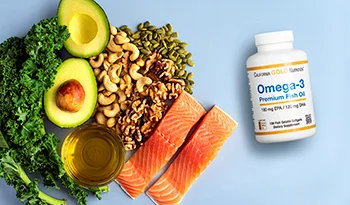Can Supplements Help Protect Against the Harmful Effects of Pollution?
FERAGAT:Bu blog tanı koymayı hedeflememektedir...
- Bu makalede:
- How Does Air Pollution Affect Our Health?
- Omega-3 Fatty Acids
- Vitamin C and Vitamin E
- Vitamin D
- Vitamin B

Air pollution is a serious and growing global health epidemic and remains a significant danger even during pandemic threats. In 2016, research showed that over 90% of the world population lives in areas where the World Health Organization’s air quality guidelines were not met.
Air pollution exposure is associated with major chronic disease states, most notably cardiac disease, and even premature births. As new research advances, premature births and glucose intolerance are showing a significant link to poor air quality environments.
These common disease states are linked to chronic air pollution exposure:
- Cardiovascular and respiratory diseases
- Glucose intolerance
- Kidney disease
- Thyroid disease
- Impaired lung function
- Chronic lung disease
- Asthma exacerbations
In a 2020 large-scale review, chronic exposure to air pollution was linked to major cardiovascular disease risk factors such as obesity and hypertension. Because of these correlations, we should protect ourselves from the potential dangers caused by air pollution, knowing we cannot completely avoid exposure. Key nutrients have been identified to lower our susceptibility to pollution damage by interfering with cellular oxidation pathways, therefore maintaining good cell health.
Before we take a look at each of these nutrients, let’s talk about how this damage occurs.
How Does Air Pollution Affect Our Health?
Air pollution particles range from large to very small (fine particulates) and travel to the air pockets of the lungs called alveoli, into the bloodstream, and to the cells of the body.
Pollutant exposure has three main effects:
- Negatively altering the autonomic nervous system, which functions to regulate cardiac function and our healthy variations in one's heartbeat.
- Overproducing reactive oxygen and nitrogen species that cause cellular damage. Our bodies’ natural antioxidants that combat this oxidative stress, such as glutathione, cannot protect against a surplus of these reactive oxygen species (ROS), enabling many chronic inflammatory processes.
- Triggering the body to produce cytokines, molecules that are secreted by our immune system and signal the body’s acute and chronic inflammatory response.
All chronic illnesses have one very important property in common—a chronic inflammatory state. Supplementing with antioxidants in the form of quality vitamins and healthy fats can boost our health potential by supporting strong organ and cellular function.
The following nutrients show the most promise.
Omega-3 Fatty Acids
This healthy fat seems to be a top player for the maintenance of health, and it wins a prize when it comes to its potential to lower susceptibility to air pollutant damage. Omega-3 fatty acids (omega-3s) block multiple inflammatory pathways in the body, inhibit cytokine production, and boost the function of macrophages, which are part of the immune system. Research has repetitively shown that omega-3s combat harmful oxidative stress at a cellular level in multiple organ systems.
In a study of healthy middle-aged adults who were supplemented with fish oil (rich in omega-3s) and exposed to an aerosolized concentrated particulate matter, acute cardiac and lipid changes in response to the pollution were significantly less than those without supplementation.
The two most beneficial omega-3s—EPA and DHA—are primarily found in certain species of fish. Many ask if consuming fish instead of taking a supplement offers the same health benefits. In a perfect world, yes. However, choosing a diet with enough fish to get the recommended daily 1–2 gram dose comes with the risk of ingesting toxic levels of heavy metals often found in fish. Supplementation with quality products such as fish oil, omega-3s, and krill oil can be an assuring way to meet the recommended heart-healthy dosage.
Vitamin C and Vitamin E
In a study investigating power plant workers exposed to coal-burning emissions, the combination of vitamin C and vitamin E supplementation showed some benefit. The researchers measured oxidative stress biomarkers in those exposed to the emissions and those unexposed. The pollution-exposed group had a decreased level of the protective marker glutathione that helps with oxidative stress.
A 2018 literature review investigated the benefit of antioxidant supplementation, such as vitamins C, E, and D, in below-standard air quality living environments to those with existing respiratory diseases such as asthma. Asthmatics with higher serum concentrations of antioxidants had a better FEV1 (forced expiratory volume 1), which is a primary measure of lung function.
Vitamin C comes in many shapes and forms, and some can be difficult for the body to both digest and utilize. The bioactive forms such as calcium ascorbate, magnesium ascorbate , and potassium ascorbate are often preferred; though the ascorbic acid form when mixed with bioflavonoids does seem to support a therapeutic benefit.
Also, some vitamin C products have added calcium and biopterin (a compound found in black pepper). Both of these agents help your body's ability to absorb nutrients. Liposomal vitamin C is an advanced form of vitamin C designed for even better absorption and utilization as well.
Vitamin D
Vitamin D deficiency receives the attention of most doctors because it affects more than one billion people worldwide and is linked to increased prevalence of depressive thoughts, joint aches, inadequate bone formation, and poor-quality sleep. Primary care doctors now realize the importance of prevention testing of vitamin D3 blood levels and supplementing when insufficient levels are present.
Air pollution has a negative effect on vitamin D levels by interfering with the amount of the sun's ultraviolet-B radiation that can penetrate the particulate haze in the air and reach human skin. Residents of polluted urban areas that are exposed to the same amount of sun hours at the same relative strength absorb significantly less vitamin D than those in rural areas.
Basking in the sun’s rays for longer improves vitamin D levels but also damages skin DNA and increases our chances of cancer. Vitamin D3 in supplement form for insufficiency and deficiency is a healthy, smart choice.
Vitamin B
The B vitamins (there are eight altogether) have a range of health benefits, from helping your body maintain balanced energy levels to strengthening hair follicles. These antioxidants also support one of the key measures of heart health, heart rate variability (HRV).
Most people who listen to a heartbeat hope to hear a steady rhythmic 1,2 pace. What is not commonly discussed is that a certain subtle amount of variation in an individual’s heart rate—HRV—measured over time is a positive predictor of heart health.
Chronic air pollution exposure is associated with a lower HRV, and research shows that consuming certain B vitamins may help maintain healthy levels of HRV. A lower HRV is directly associated with increased cardiac mortality.
Olive Oil
The rich taste of extra virgin olive oil when drizzled across a meal is appealing to the senses, and also helps your immune system fight harmful reactive oxygen species in the body.
A recent study in January of 2020 that evaluated the effects of traffic-related air pollution and the role of the Mediterranean diet found consistent evidence that the antioxidant-rich diet was effective in mitigating the harmful effects of low-quality air. One of the main staples of the Mediterranean diet includes incorporating olive oil as the main source of added fat in abundant quantities of about 2 to 4 tablespoons a day.
Olive oil is full of heart-healthy compounds called phenols, in addition to having high antioxidant properties. When choosing an olive oil, remember this monounsaturated fat is a fruit juice—the juice of the olive fruit—and has a limited shelf life. Because exposure to light and heat can degrade the quality of any olive oil over time, a darker glass bottle is a better choice.
Extra virgin olive oil is packed with more healthy phenols than olive oil labeled pure or light. Cold-pressed olive oil varieties are exposed to heat during the manufacturing process, which is better for preserving its immune-boosting compounds.
Each of these nutrients has additional power-packed benefits, so considering supplements in adverse environmental conditions is likely to support your overall wellness and may even help you fight off disease progression.
References:
- Evolution of WHO air quality guidelines: past, present and future. Copenhagen: WHO Regional Office for Europe; 2017.
- Mendola P, Wallace M, Hwang BS, et al. Preterm birth and air pollution: Critical windows of exposure for women with asthma. J Allergy Clin Immunol, 2016. 138(2): p. 432-40.e5.
- Kim JB, Prunicki M, Haddad F, et al. Cumulative Lifetime Burden of Cardiovascular Disease From Early Exposure to Air Pollution. J Am Heart Assoc. 2020 Mar 17; 9.
- Brook RD. Cardiovascular effects of air pollution. Clin Sci (Lond). 2008;115(6):175-87.
- Peters A. Particulate matter and heart disease: evidence from epidemiological studies. Toxicol Appl Pharmacol. 2005;207(2 Suppl):477-82.
- Brook RD, Rajagopalan S, Pope CA, 3rd, et al. Particulate matter air pollution and cardiovascular disease: An update to the scientific statement from the American Heart Association. Circulation. 2010;121(21):2331-78.
- Miller MR. The role of oxidative stress in the cardiovascular actions of particulate air pollution. Biochem Soc Trans. 2014;42(4):1006-11.
- Wolf K, Popp A, Schneider A, et al. Association Between Long-term Exposure to Air Pollution and Biomarkers Related to Insulin Resistance, Subclinical Inflammation, and Adipokines. Diabetes. 2016;65(11):3314-26.
- Watkins DJ, Josson J, Elston B, et al. Exposure to perfluoroalkyl acids and markers of kidney function among children and adolescents living near a chemical plant. Environ Health Perspect. 2013;121(5):625-30.
- Lopez-Espinosa MJ, Mondal D, Armstrong B, et al. Thyroid function and perfluoroalkyl acids in children living near a chemical plant. Environ Health Perspect. 2012;120(7):1036-41.
- Pope CA, 3rd, Burnett RT, Thun MJ, et al. Lung cancer, cardiopulmonary mortality, and long-term exposure to fine particulate air pollution. JAMA. 2002;287(9):1132-41.
- Raaschou-Nielsen O, Andersen ZJ, Beelen R, et al. Air pollution and lung cancer incidence in 17 European cohorts: prospective analyses from the European Study of Cohorts for Air Pollution Effects.
- Rojas-Martinez R, Perez-Padilla R, Olaiz-Fernandez G, et al. Lung function growth in children with long-term exposure to air pollutants in Mexico City. Am J Respir Crit Care Med. 2007;176(4):377-84.
- Nel AE, Diaz-Sanchez D, Li N. The role of particulate pollutants in pulmonary inflammation and asthma: evidence for the involvement of organic chemicals and oxidative stress. Curr Opin Pulm Med. 2001;7(1):20-6.
- Bouazza N, Foissac F, Urien S, et al. Fine particulate pollution and asthma exacerbations. Arch Dis Child. 2018, Sep; 103 (9): 828-831.
- Kim JB, Prunicki M, Haddad F, et al. Cumulative Lifetime Burden of Cardiovascular Disease From Early Exposure to Air Pollution. J Am Heart Assoc. 2020 Mar 17;9(6).
- Holguin F, Tellez-Rojo MM, Hernandez M, et al. Air pollution and heart rate variability among the elderly in Mexico City. Epidemiology. 2003;14(5):521-7.
- Poljsak B, Fink R. The protective role of antioxidants in the defense against ROS/RNS-mediated environmental pollution. Oxid Med Cell Longev. 2014;2014:671539.
- Yates CM, Calder PC, Ed Rainger G. Pharmacology and therapeutics of omega-3 polyunsaturated fatty acids in chronic inflammatory disease. Pharmacol Ther. 2014 Mar;141(3):272-82.
- Tong H, Rappold AG, Diaz-Sanchez D, Steck SE, et al. Omega-3 fatty acid supplementation appears to attenuate particulate air pollution-induced cardiac effects and lipid changes in healthy middle-aged adults. Environ Health Perspect. 2012 Jul;120(7):952-7.
- Yates CM, Calder PC, Ed Rainger G. Pharmacology and therapeutics of omega-3 polyunsaturated fatty acids in chronic inflammatory disease. Pharmacol Ther. 2014 Mar;141(3):272-82.
- Possamai FP, Junior SA, Parisotto EB, et al. Antioxidant intervention compensates oxidative stress in blood of subjects exposed to emissions from a coal electric-power plant in South Brazil. Environ Toxicol Pharmacol. 2010;30(2):175-80.
- Whyand T, Hurst JR, Beckles M, Caplin ME. Pollution and respiratory disease: can diet or supplements help? A review. Respir Res. 2018;19(1):79. Published 2018 May 2.
- Barthelemy J, Sanchez K, Miller MR, et al. New Opportunities to Mitigate the Burden of Disease Caused by Traffic Related Air Pollution: Antioxidant-Rich Diets and Supplements. Int J Environ Res Public Health. 2020 Jan 18;17(2).
- Sizar O, Khare S, Goyal A, et al. Vitamin D Deficiency. [Updated 2020 Feb 26]. In: StatPearls [Internet]. Treasure Island (FL): StatPearls Publishing; 2020 Jan.
- Manicourt DH, Devogelaer JP. Urban tropospheric ozone increases the prevalence of vitamin D deficiency among Belgian postmenopausal women with outdoor activities during summer. J Clin Endocrinol Metab. 2008;93(10):3893-9.
- Baccarelli A, Cassano PA, Litonjua A, et al. Cardiac autonomic dysfunction: effects from particulate air pollution and protection by dietary methyl nutrients and metabolic polymorphisms. Circulation. 2008;117(14):1802-9.
- Whyand T, Hurst JR, Beckles M, Caplin ME. Pollution and respiratory disease: can diet or supplements help? A review. Respir Res. 2018;19(1):79. Published 2018 May 2.
- Barthelemy J, Sanchez K, Miller MR, et al. New Opportunities to Mitigate the Burden of Disease Caused by Traffic Related Air Pollution: Antioxidant-Rich Diets and Supplements. Int J Environ Res Public Health. 2020 Jan 18;17(2).

 Kaynak: Dr. Nicole Craven, M.D.
Kaynak: Dr. Nicole Craven, M.D.


